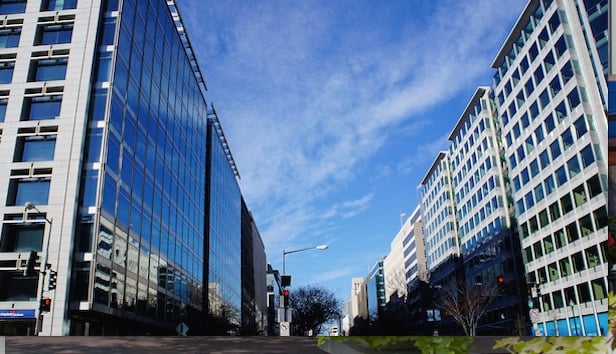WASHINGTON, DC–A whopping $2.3 billion in CMBS loans became newly delinquent in February, with over $1.5 billion of that total coming from office delinquencies, Trepp reported earlier this month. It was the second straight month in which newly delinquent loans exceeded $2 billion.
CMBS late-pays have been steadily rising over the last year — for February it ticked upward by 13 basis points to 5.31% — and now this trend is starting to have a noticeable impact on major markets, including Washington DC. Typically, CMBS financing is used in second tier markets where other forms of finance can be harder to secure. Major markets tend to have less CMBS loans on their assets on a relative basis and therefore, fewer delinquencies. So it is particularly noteworthy when the delinquency rate increases for these markets.
The Washington DC area delinquency rate reached 14.37% in February, the highest it's been in a year, according to Trepp's breakdown of the area's CMBS loan activity. (Keep in mind as the overall pool gets smaller, the late-pay rate will invariably go up. But the bottom line is, delinquencies are rising, they are not staying stagnant.)
Indeed, one of the area's delinquent loans made it onto Trepp's list of the top five loans by balance that went into delinquency last month: the last piece of once-current debt behind the massive Skyline Portfolio. In February, a $131.2 million B note fell into delinquency. According to Trepp:
After being listed as going through the foreclosure process in September and October 2016, the note was made current in the following three months. However, the asset has been returned to the lender and is now REO. Four of the six pieces behind the portfolio are REO, while two slices … are still “in foreclosure.” The eight offices that collateralize the debt were foreclosed on in October. The B note isn't carrying an appraisal reduction at this time, but most of the other Skyline pieces are.
Meanwhile, new issuance continues for the area. Trepp data also shows that six new CMBS loans were issued for properties in the region — all of which were in Northern Virginia. They were largely for retail properties, which should not be a surprise given that CMBS is used to primarily finance retail and office assets, Research Analyst Sean Barrie tells GlobeSt.com.
WASHINGTON, DC–A whopping $2.3 billion in CMBS loans became newly delinquent in February, with over $1.5 billion of that total coming from office delinquencies, Trepp reported earlier this month. It was the second straight month in which newly delinquent loans exceeded $2 billion.
CMBS late-pays have been steadily rising over the last year — for February it ticked upward by 13 basis points to 5.31% — and now this trend is starting to have a noticeable impact on major markets, including Washington DC. Typically, CMBS financing is used in second tier markets where other forms of finance can be harder to secure. Major markets tend to have less CMBS loans on their assets on a relative basis and therefore, fewer delinquencies. So it is particularly noteworthy when the delinquency rate increases for these markets.
The Washington DC area delinquency rate reached 14.37% in February, the highest it's been in a year, according to Trepp's breakdown of the area's CMBS loan activity. (Keep in mind as the overall pool gets smaller, the late-pay rate will invariably go up. But the bottom line is, delinquencies are rising, they are not staying stagnant.)
Indeed, one of the area's delinquent loans made it onto Trepp's list of the top five loans by balance that went into delinquency last month: the last piece of once-current debt behind the massive Skyline Portfolio. In February, a $131.2 million B note fell into delinquency. According to Trepp:
After being listed as going through the foreclosure process in September and October 2016, the note was made current in the following three months. However, the asset has been returned to the lender and is now REO. Four of the six pieces behind the portfolio are REO, while two slices … are still “in foreclosure.” The eight offices that collateralize the debt were foreclosed on in October. The B note isn't carrying an appraisal reduction at this time, but most of the other Skyline pieces are.
Meanwhile, new issuance continues for the area. Trepp data also shows that six new CMBS loans were issued for properties in the region — all of which were in Northern
Want to continue reading?
Become a Free ALM Digital Reader.
Once you are an ALM Digital Member, you’ll receive:
- Breaking commercial real estate news and analysis, on-site and via our newsletters and custom alerts
- Educational webcasts, white papers, and ebooks from industry thought leaders
- Critical coverage of the property casualty insurance and financial advisory markets on our other ALM sites, PropertyCasualty360 and ThinkAdvisor
Already have an account? Sign In Now
*May exclude premium content© 2024 ALM Global, LLC, All Rights Reserved. Request academic re-use from www.copyright.com. All other uses, submit a request to [email protected]. For more information visit Asset & Logo Licensing.











